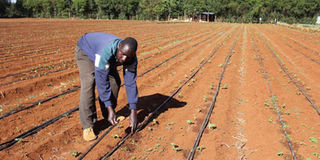Important tips to ensure you get the best out of drip irrigation system

A farmer fixes drip irrigation lines in a farm. Most drip tapes in Kenya are designed to work under very low gravity pressure. PHOTO | FILE | NATION MEDIA GROUP
What you need to know:
- According to the United Nations, Kenya’s renewable water resource per capita is below 1,000 cubic metres or 1,000,000 litres per person annually.
- A drip irrigation system is user-friendly, though relatively expensive to set up. It has the highest productivity per unit area and low crop root and leaf disease incidence because the water has no direct interaction with the leaves.
- Your drip irrigation system will work well under high pressure using a water pump or low gravity pressure.
Kenya is a water-scarce country. According to the United Nations, Kenya’s renewable water resource per capita is below 1,000 cubic metres or 1,000,000 litres per person annually.
The country has one of the lowest water replenishment rates in the world, which is why drip irrigation has gained wide adoption among farmers; because it utilises little water.
A drip irrigation system is user-friendly, though relatively expensive to set up. It has the highest productivity per unit area and low crop root and leaf disease incidence because the water has no direct interaction with the leaves.
Your drip irrigation system will work well under high pressure using a water pump or low gravity pressure.
Dos and don’ts of drip irrigation
i) Irrigation time. Early morning watering is the best so that the soil warms up during the day. Cold wet soil is a precursor for root infections in many commercial crops.
ii) Flow rate. The higher your emitter flow rate, the higher the rate of watering and less incidence of emitter clogging. Farmers are encouraged to use drip tapes with emitter flow rates from 1.5 litres per hour.
iii) Drip line thickness. 0.4mm thickness and above is well suited for tropical open field crops. It lasts longer. 0.3mm thick drip tapes can be used in the greenhouse where there’s less solar radiation exposure, otherwise they have a shorter lifespan in the open field.
iv) Water supply pressure. Most drip tapes in Kenya are designed to work under very low gravity pressure (from 1.5 metres head or 0.15 bar). When using high pressure, consider using double emitter drips pipes or high pressure models.
v) Emitter spacing. Your choice is based on the volume of water needed by the crop. A drip line with an emitter spacing of 15cm will water more per unit area than a 30cm line.
Wamae Mwangi is a director at Grekkon Limited - Irrigation Hub. [email protected]



